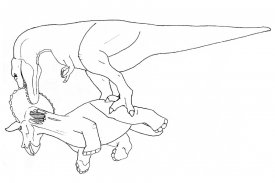Theirs was the immortal battle: a fierce tyrant battling a defender armed with three lethal horns and protected by a bony frill around its neck. Yet the violent fight between Tyrannosaurus and Triceratops is hardly the stuff of Hollywood hype. Tyrannosaurus bite marks are well known on the fossil bones of Triceratops but, so far, such fossils have always been studied in an isolated manner.
In a departure from this precedent, work presented last week at the Society of Vertebrate Paleontology’s annual meeting in Raleigh, North Carolina, reports on an examination of numerous bite-scarred Triceratops bones and a theory of how Tyrannosaurus fed.
Denver Fowler at the Museum of the Rockies in Bozeman, Montana, and his colleagues studied numerous Triceratops specimens from Montana's Hell Creek Formation to identify how many had the characteristic tooth marks of Tyrannosaurus on them. They found 18, most of which were skulls. When they looked closer, they noted something important: none of the bones showed any signs of healing, indicating that the bites were inflicted on dead animals that were in the process of being eaten.













